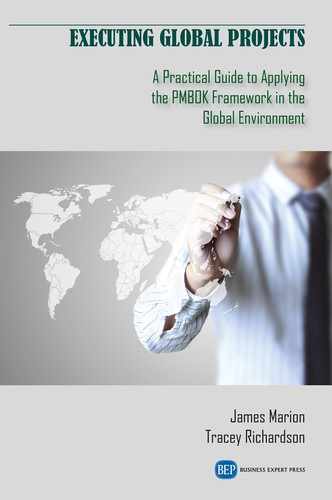Starting and Planning the Global Project
What is so special about projects that are planned and executed within the global environment? Why should project managers concern themselves with examining global projects as something distinct from projects that are purely local, regional, or national in scope? This question may be answered in a single word—complexity. Global projects include significantly more variables to manage including the macroenvironment. The global macroenvironment is vast and includes the political, economic, social, and technological factors in which a global project is executed. Further, project managers encounter language and cultural barriers that often involve fundamentally different approaches to management itself. To make an analogy, when project managers face such factors, it is rather like attempting to drive a car from one location to another while wearing a blindfold. The environment faced by the project manager may be quite alien, thereby leading to confusion, miscommunication, conflict, and stress. On the other hand, when project managers take the time to understand the global project management environment and become more comfortable with the added complexity, it is not uncommon to find global project management to be a successful and rewarding experience (Figure 1.1).

Figure 1.1 The global project management environments
Whether a project manager desires to lead a global project or not, projects today are increasingly global in scope. Often an apparently purely local project will include some components, subsystems, software, technology, or labor sourced from outside of the home country. As a result, even local project managers may be required to communicate with or travel to suppliers who are outside of the home country. These requirements present little problem since modern technology has made it possible to communicate in real time anywhere on the globe. Further, jet travel makes it possible to travel from any major city in the world to any other major city in less time than it was required to travel between the original Greek city states in antiquity. The world is effectively smaller—but since the world is round and it is not physically smaller, the apparent smallness enables global projects but leaves the additional stresses, strains, and complexities in place. Jumping into a global project without serious consideration of the many facets of the global macroenvironment is much like planning a project that includes a significant component of scope that is hidden and not revealed until later in the project. There is more at stake, more at risk, and more for the project manager to do in a global project than any project that is carried out on a purely local scale.
Complexity = Risk
The many additional factors that a global project manager must consider effectively increases the overall project risk. Like any project risk uncovered by the project team, the risks associated with the global environment may be identified, analyzed, ranked, and linked to appropriate risk responses. Given the special nature of the global macroenvironment, a separate and distinct “global risk register” may be created to track and keep an ongoing appraisal of global risks. Further, in large-scale projects—which global projects often are—it is recommended to have a project team member assigned to “own” and lead the project team in managing these risks (Figure 1.2).
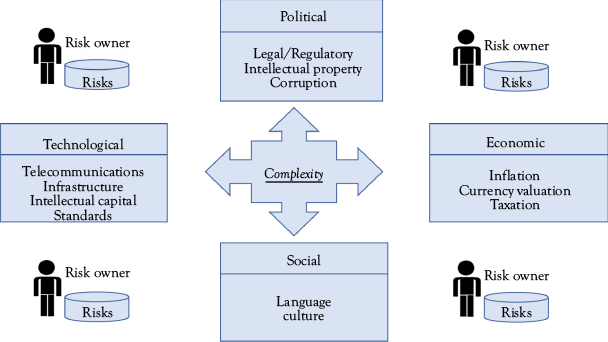
Figure 1.2 Global risk and risk owners
One reason for approaching global project risks in this manner is that the logistics of implementing risk responses is likely to be far more complex than that involved in purely localized risk responses. It is simpler to call a meeting with local suppliers to resolve an issue, but addressing problems with suppliers and contractors in Eastern Europe, India, and Asia—at the same time—presents unique difficulties. The scale of global risks that materialize into issues are likely to reach the scope of a major subproject. It is for this reason that in-depth global project risk identification, risk analysis, and risk response scenario planning is assigned to and carried out by the owner of the global project risk register.
Start with “SWOT the PEST”
The Guide to the Project Management Body of Knowledge (PMBOK) includes knowledge areas associated with each discipline required for carrying out each of the process groups. There is no single process group associated with managing a project within the global environment—but perhaps there should be. At minimum, a project team could create, as is required in most knowledge areas, a “plan for a plan,” that is, a strategy for managing each of the knowledge area disciplines in the context of complexities unique to the global environment. Another way of saying this is to “develop a strategy” for planning and executing the global project. A good practice in strategic management suggests that the place to start in developing strategy is to begin by evaluating the “big picture” by assessing both the internal and external environment of the firm and sizing up the resulting strengths and weaknesses. The “big picture” evaluation is followed by identifying what appropriate actions should be taken to shore up weaknesses as well as enhance strengths. This could be thought of as identifying “positions to defend” as well as “positions to achieve” within the project considering the project capability today (“as-is”) as well as where the project needs to be in the future (“to-be”). The process of global strategy development within the project environment need not differ significantly from that of the firm—the primary exception being the temporary nature of the project as well as its focus on producing tangible deliverables.
The Big Picture
The big picture view of strategy begins with the analysis of the Strengths, Weaknesses, Opportunities, and Threats, or SWOT analysis of the project as it faces the global macroenvironment. A mnemonic device for SWOT analysis in global projects is the phrase “SWOT the PEST,” or the evaluation of “Strengths, Weaknesses, Opportunities and Threats in light of the Political, Economic, Social and Technological environment” in which the project is planned and executed. In the corporate environment, a SWOT analysis is focused on attaining and maintaining a competitive advantage. In the global project environment, “SWOTting the PEST” is all about understanding the capabilities, liabilities, opportunities, and vulnerabilities given the additional factors afforded by the global environment. One approach to doing this is to carry out a brainstorming session where each PMBOK knowledge area is analyzed using a SWOT analysis with a special focus on PEST. A generic example of the output of this process is provided in Table 1.1 (Project Management Institute 2017).
Table 1.1 SWOT analysis of PMBOK knowledge areas
|
Knowledge Area |
Strength |
Weakness |
Opportunity |
Threat |
|
Integration |
Process differences Decision making |
|||
|
Scope |
Change |
Hidden additional scope |
||
|
Schedule |
||||
|
Cost |
Travel, communication, currency valuation |
|||
|
Quality |
||||
|
Resources |
Virtual team management |
Software |
||
|
Communication |
Language, Culture |
Intranet |
Misunderstanding |
|
|
Risk |
||||
|
Procurement |
Logistics |
Taxes, duties |
||
|
Stakeholders |
Geographical distance |
Upon completion of the SWOT analysis, the project team makes an assessment of the special focus and possible additional action that must be taken in developing subplans associated with each knowledge area. As a first step, the project team can consider what modification may be required for the management of each knowledge area by asking specific questions that will be answered in the associated plans that are developed. These questions are developed in the global project knowledge area walkthrough.
Global Project Strategy Process
Project management is known to have borrowed process support from operations management. One example of this is the quality management processes that are consistent with quality policies in operations. Likewise, the global project team may consider borrowing processes from strategic management to more fully consider how to strategically produce an effective plan that successfully addresses global risks. The first step in the strategic management process is analysis. The analysis phase is characterized by the SWOT analysis to understand those global factors of concern within each process. The analysis phase may be concluded with a workshop that reviews the findings of the SWOT analysis.
Global Project Knowledge Area Walk-Through
A walk-through of each knowledge area may be accomplished using techniques used in project planning workshops. Instead of identifying and sequencing activities, the focus is on identifying questions that each element of the global project plan must answer, as follows:
Integration
Who will participate in the development of the overall project plan, and how will globally distributed teams contribute to it?
What decisions will need to be made in the development of the project plan, and to what extent will local teams participate in such decisions?
What language, culture, or distance barriers stand in the way of developing the overall project plan?
Scope
What additional elements of scope would need to be added because of international standards? What legal and standards-based factors must be included in the scope of the project?
How will the project requirements be collected?
How will trade-offs between local and global scope requirements be managed?
How will the integrated change control process function in an environment of globally distributed teams?
Schedule
To what extent does international logistics and travel impact the project schedule?
What impact will the difference in holidays and observances impact the project schedule?
Cost
What costs should be considered that go beyond typical expenditures for local projects?
In what currencies will costs be tabulated?
What commercial terms will the project team face that have the potential to increase project costs?
Quality
What quality standards must be considered when defining the project?
What regional differences in quality standards must be researched and evaluated?
Resources
From where should management and labor resources be sourced?
In what location(s) will capital and labor resources be housed?
Communication
What steps should be taken to avoid miscommunication given language differences?
When and how often should communication take place between the local and geographically dispersed teams?
What changes in timing of synchronous communication should be considered given different time zones?
Where and how often will face-to-face communication take place?
Risk
Will the project require additional insurance to deal with travel and extended local residence of team members?
What additional resources must be assigned to risk mitigation plans?
What measures must be undertaken in order to ensure the personal safety of team members around the world?
Procurement
From where will the project obtain hardware and software components, materials, and subcontractors?
What additional steps must be taken by the project to ensure quality of vendor-supplied components and labor?
How will the project team assess the financial health and process maturity of globally distributed suppliers?
Stakeholders
What high-power/high-interest stakeholders may exist in globally distributed locations about whom the project team is not currently aware?
How will stakeholders from different cultures and different languages be effectively engaged?
The project team, in the course of developing the global project plan, must carefully consider the questions raised in the knowledge area walk-through and ensure that the project plan sufficiently answers each of the questions.
Considering Options
The next stage in the strategic management process is strategy formulation. In global project management, this roughly equates to outlining several generic options that may be applied in responding to the risks identified in the analysis phase. One approach for considering response plan possibilities is to conduct scenario planning (Figure 1.3).
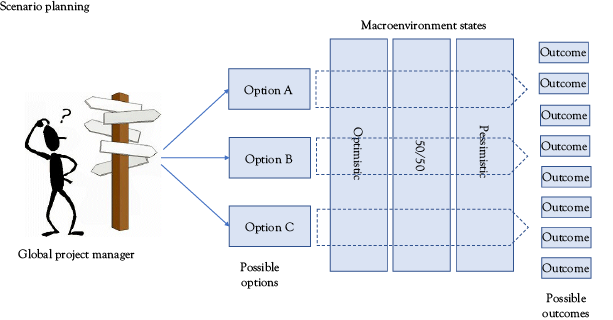
Figure 1.3 Global project scenario planning
For every risk scenario, the project team creates several possible approaches to dealing with the risk. Further, an overriding risk philosophy or policy approach to various categories of identified risk may begin to gel. At the formulation stage, the more global project strategic risk response options available from which to select the better for the project.
Selecting Options
After analysis and formulation, the strategic management process requires a choice of strategy. In global project management terms, strategic choice equates to making decisions between alternative response scenarios. Deciding between several different risk response options can often be a daunting task. On the other hand, response options could be thought of as small projects. For this reason, it makes sense to employ techniques from the PMBOK that are designed for just this purpose. Project selection methods include both qualitative as well as quantitative methods. A qualitative approach, applying expert judgment, could employ a simple checklist that outlines what is of greatest concern to the global project team (Figure 1.4).
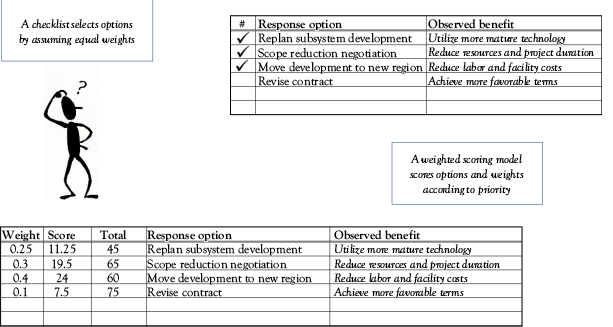
Figure 1.4 A weighted scoring model for global projects
Further, the checklist could evolve to a weighted ranking matrix in which weights are applied to each element of the checklist. Quantitative approaches to global risk plan decision-making consider the financial aspects of the global risk response plan. A quantitative analysis such as the net present value, the return on investment, or the expected monetary value of the decision tree inform the project manager if the response generally produces gains greater than the projected costs. However, the cost of the response plan should be less than the cost of the risk itself. Otherwise, it is preferred to simply accept the risk without necessarily preparing an extended response plan.
Implementation
The final stage of the strategic management process is strategy implementation. This stage involves putting in motion the strategies that were decided from analysis, formulation, and choice. The analog in the context of global project management is to charter subprojects designed to plan and implement responses to global risk scenarios. Since in each case the plans are addressing risks (rather than risks that have materialized to become issues), implementation at this stage may be as simple as creating subproject charters and accompanying scope statements to have on standby should they become necessary to employ.
What Would a Global Project Knowledge Area Look Like?
A knowledge area within the PMBOK that provided specific process support for managing global projects would guide project teams to identify and understand the unique elements of a global project that require significant planning and close management. Further, such a knowledge area would direct teams to assess their own fitness and any necessary corrective action for managing the global project. Finally, the knowledge area would direct the team to develop plans for managing global project factors with emphasis on risk management. An additional knowledge area for the global environment would provide guidance on the development of project subplans to address the impact presented by additional global factors, and as well, identify, analyze, and plan risk responses for risks unique to the global environment (Table 1.2)
Table 1.2 A global project management knowledge area
|
Global project factor management |
Description |
|
Identify global project factor impacts |
Identify impact to the project of distance, culture, language, social, political, and regulatory matters. |
|
Conduct global project SWOT analysis |
Assess Strengths, Weaknesses, Opportunities, and Threats associated with the global Political, Economic, Social, and Technological Environment |
|
Plan management of global project factors |
Identify and select strategy for managing identified global project factors |
|
Identify global risk factors |
Identify specific risks unique to the global project environment |
|
Plan global risk factor responses |
Develop plans resulting from evaluating risk scenarios and developing and selecting strategies for addressing global risks. |
Risks Unique to the Global Environment
The political and legal environment will naturally differ from country to country. This means that a project team creating the plan must be familiar with local regulations. In some environments, the legal environment proves so daunting that local legal representation including contact with local government officials will be required. An example of this is in carrying out a project within a country led by a strong central government such as the People’s Republic of China. In this context, if the project involves construction, installation, or long-term stays of any kind, local legal representation with ties to local and regional government is a must. There is no substitute for local know-how when it comes to the regulatory and legal environment in which the project interacts. Never assume that the details of the local environment can be understood and adapted to by carrying out cursory research on the subject. It is also important to remember that project managers working in a different country are guests of that country and should take care not to cause offense (Figure 1.5).
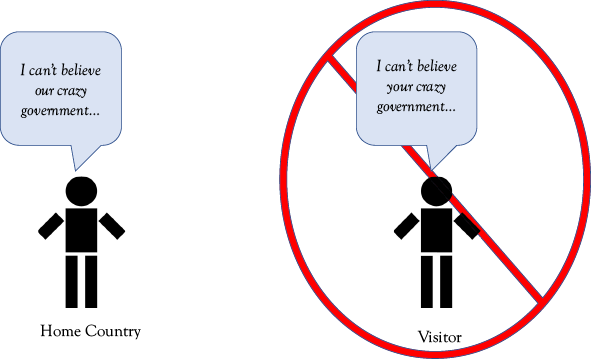
Figure 1.5 What not to say when visiting another country
Example of Unintended Offense
A classic example of the potential to cause unintended offense could be illustrated by the pitfalls of using the wrong terminology when doing business in the People’s Republic of China. In the People’s Republic of China, it is considered an insult to the government to refer to Taiwan in formal or informal communication as the Republic of China (ROC). The People’s Republic of China in Mainland China does not recognize Taiwan as being an independent republic. Therefore, simply mentioning it can cause great offense and can lead to the ejection of the project team from the country. This is an example of an unintended political insult that can cause significant friction. Although it is common when traveling to other countries to find that the locals are perfectly content to work together with Western project managers, there may be considerable political differences that exist between the country being visited and the project team country of origin. There is an old saying that “…one should never discuss religion and politics in church.” Global project managers should keep this in mind and particularly avoid opinionated conversations about political trends, the activities of different governments, or religious differences. If project team members do encounter criticism of the home country, its political leaders, religion, or culture, it is best to let it pass without comment.
Personal Safety
The personal safety of project team members when travelling the globe on project business cannot be taken for granted. The international environment may present challenges for personal safety that may not exist to the same degree in the home country. Safety concerns may involve crime, but other concerns exist as well and include fundamental concerns such as the presence of disease and the lack of food safety due to unsanitary conditions. Other more fundamental physical concerns such as extreme heat, cold, or excessive humidity may present unexpected challenges if not considered in advance. There may also be significant seasonal changes depending upon the hemisphere destination. Prior to sending anyone to another country for work on a project consider such factors as possible risks to personal safety. Examine reports published by the State Department and the Center for Disease Control on the state of crime, terrorism, and other physical and health concerns for personal safety to expect in the given country. Also confirm with a local doctor what vaccinations and medications should be used by the project team member before or perhaps during travel.
The PMBOK Versus International Standards
Using the knowledge areas of the PMBOK can be very useful to capture in detail how risk associated with international project management can impact the project. However, using the knowledge areas as a means for organizing risk analysis reflects the fact that the team is using the PMBOK framework as the primary reference standard for project planning and execution. It should be acknowledged though that not all project teams around the world will be as immersed in the PMBOK as a team that is based in the Western world, particularly the United States. Many different project management frameworks exist around the globe. The Global Alliance of Project Management Professionals (GAPP) seeks to coordinate and consolidate the different project management standards that do exist so that global project managers may be aware of the different standards. An inspection of the GAPP website illustrates that differences exist between project management standards around the world. It is also evident that there are many commonalities. In all cases projects must be started, planned, executed, monitored, controlled, and closed—even though the terminology associated with this sequence may differ. Also, even though the PMBOK outlines 10 knowledge areas with specific skill requirements for managing each of the process groups. Such skill requirements are not uncommon in most of the international standards. Two of the more common international project management standards include PRINCE2 and the International Project Management Association standard (Figure 1.6) (Global Alliance for the Project Professions 2019).
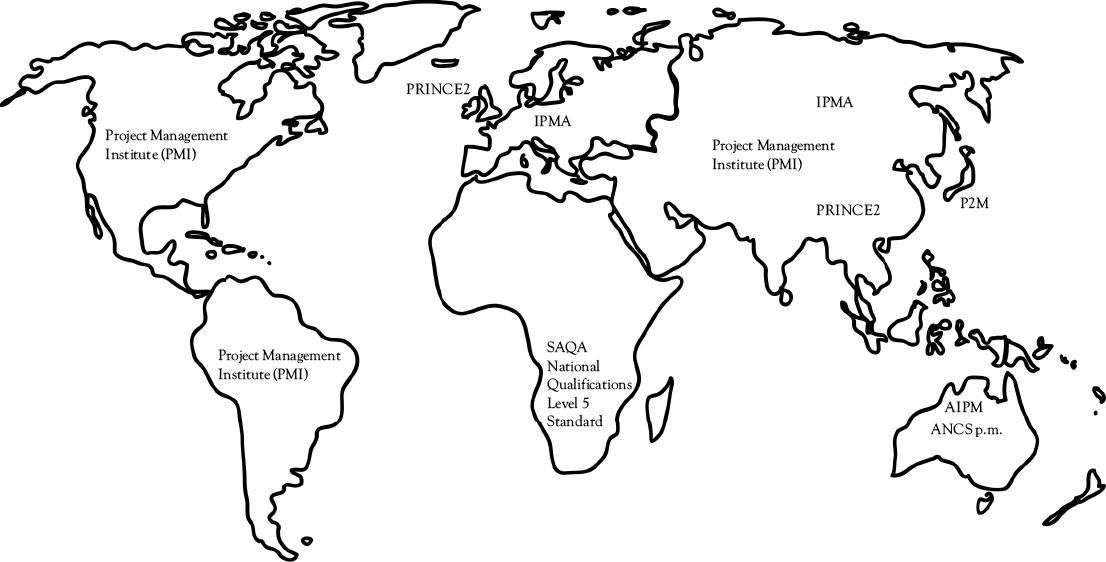
Figure 1.6 Global project management standards
The fact that fundamental differences in project management standards suggests that the team leading the global project should take time to meet with local teams in order to agree upon which standard will be used and, if necessary, harmonize an approach to developing the global plan. Just as importantly, the team leading the global project should not assume that globally distributed teams, partners, or suppliers follow the same project standard that the team in the head office follows. Finally, an awareness of the terminology and the process steps employed in global project standards may help with the translation process when communicating the project lifecycle and the governance process. It is possible that different project management standards may use different terminology for commonly used processes. Developing an understanding of the differences in terminology may help considerably in reducing confusion and miscommunication.
Plan Review and Kick-Off
A general rule of thumb for developing a project plan is that for a plan to be effective, those charged with carrying out the plan must have a role in developing it. In the purely local environment, this is rarely challenging. Most of the high-level planning may be carried out by a co-located project team within the setting of a planning workshop. How does this work in the global environment? There are multiple ways of addressing this. First, the planning documentation as it is developed may be stored on an intranet site in which all distributed teams have access (Figure 1.7).

Figure 1.7 Central project plan repository for global projects
When updates occur, all local teams are alerted and directed to the updated plan and change log via a link. In addition to frequent information updates, virtual workshops using teleconferencing technology may be conducted to collect input and recommendations from distributed teams. A more taxing and expensive approach is to have the project team visit a different local site at each phase review with other sites joining in via teleconference. Regardless of the logistic difficulties of this approach, it does provide the opportunity for a greater degree of feedback and interaction between the project team and the local environment. Regardless of periodic communication and face-to-face visits with local teams, the formal final review of the plan and kick-off of the project is best done with representatives of the project teams around the world in a single-location workshop setting.
